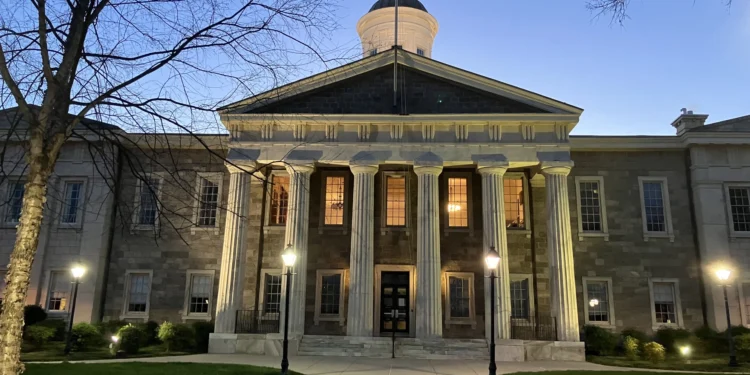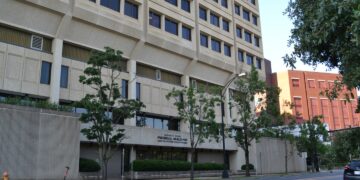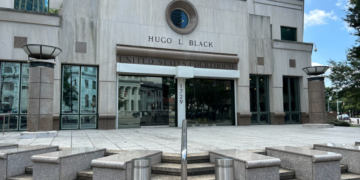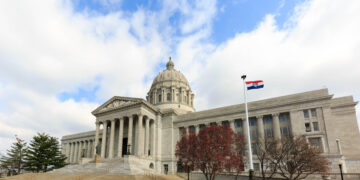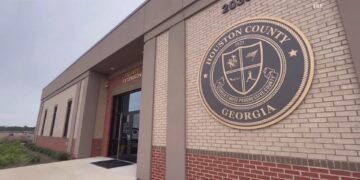June 10, 2025 Story by: Publisher
Baltimore County’s independent Redistricting Commission voted 4–3 to approve a sweeping new map on Monday, June 10, that expands County Council districts from seven to nine. This historic reconfiguration aims to better represent shifting demographics, foster fair representation, and align local governance to the results of the 2020 Census and a recent voter-approved expansion of the council.
The final proposal, dubbed the “2‑2‑5 plan,” features:
- Two majority-Black districts in the western part of the county
- Two additional minority-majority districts—one on the western side, the other in the east
- Five districts retaining a white-majority demographic
Commissioner Michelle Davis, a resident of Windsor Mill and former District 1 representative, introduced the plan. She emphasized the compromises needed to shape a fair map: “We all had to give consideration, to give a little in order to get a little.”
The Baltimore County Redistricting Commission approached a June 13 deadline to recommend new council district boundaries, and discussions intensified over ensuring fair representation for the county’s diverse population.
The commission, formed to propose revisions to the county’s council maps, has faced persistent scrutiny from voting rights advocates and civil rights groups who argue the redistricting process risks undermining Black and minority voting power.
This comes on the heels of ongoing litigation and public pressure following the 2022 federal court decision that found the county’s previous redistricting map violated the Voting Rights Act by diluting Black voting strength. In response, Baltimore County revised its maps, but many advocates argue the changes still fall short.
Background
The newly formed Commission was established by the County Council on December 16, 2024, following a ballot-approved decision to expand the council. Their mandate: present a final map by October 1, 2025, for use in the 2026 elections
Over several months, the body conducted a series of public hearings—both in-person and virtual—across East and West Baltimore County (May 12 in Middle River, May 19 in Randallstown). Through community input and multiple revisions, the Commission prioritized:
- Population equality (each new district approx. 95,000 residents)
- Compliance with the Voting Rights Act
- Preservation of community identities and shared interests
What’s Next?
Following narrow approval, the proposed map, along with a Commission report, now moves to the County Council. By law, the Council must adopt final district boundaries by October 1, 2025—an accelerated timeline given the expanded council structure.
Once approved, the nine-member County Council will operate under this new map for the 2026 election cycle.
Commission’s Vote and Deliberation
The approval passed with a slim margin—5 votes in favor and 4 opposed—highlighting the deep divisions among commission members about how best to redraw district boundaries following the 2020 census. The newly approved map, which aims to reflect population changes and ensure equitable representation, replaces the previous 7-district configuration with a more granular 9-district plan.
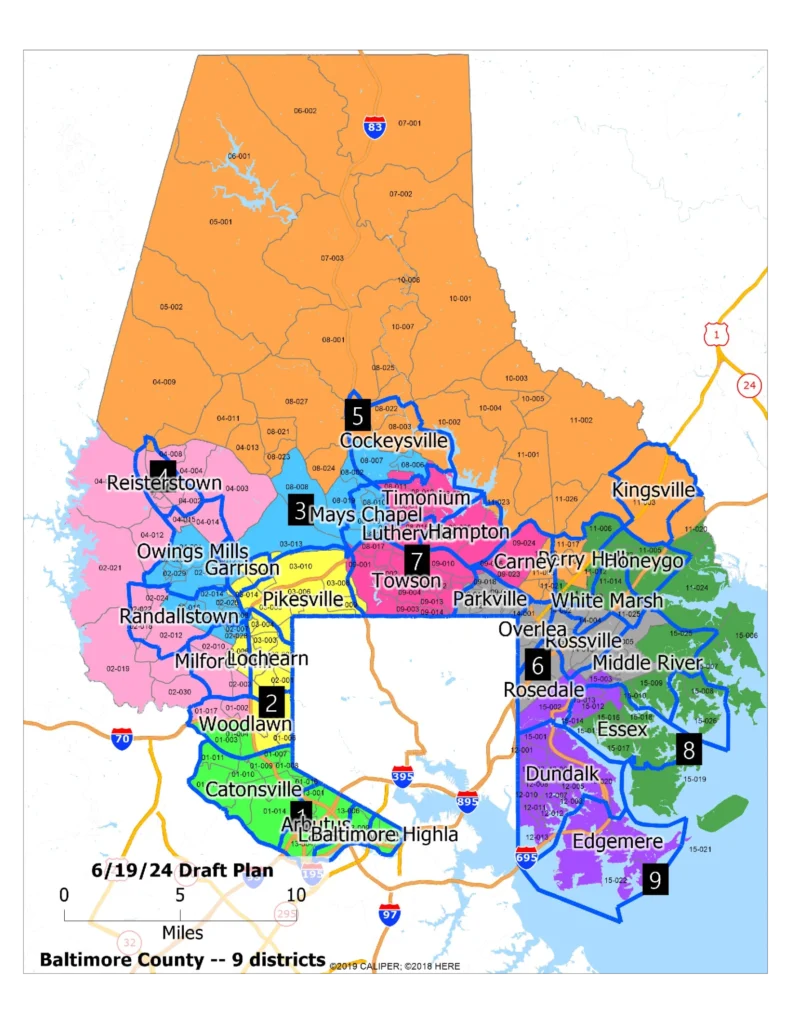
Photo caption: The ACLU’s proposed map. Districts 2, 3, and 4 would be Black-majority districts. (Photo courtesy of:The ACLU)
Opponents of the plan expressed concerns that the proposed districts could dilute minority voting strength and potentially favor incumbents from certain political parties. Supporters argued that the new boundaries more accurately reflect demographic shifts, population growth, and the need to adhere to legal mandates about population equality per district.
Historical Context
Baltimore County’s redistricting challenges are part of a broader struggle in Maryland and across the United States to ensure equitable representation following the 2013 Shelby v. Holder Supreme Court decision, which invalidated key provisions of the Voting Rights Act, including preclearance requirements for jurisdictions with histories of voter suppression. Since then, counties like Baltimore have faced renewed pressure to uphold minority voting rights without federal oversight.
Redistricting in Baltimore County follows each decennial census, as mandated by Section 207 of the county charter. The process requires the formation of a redistricting commission to propose new district boundaries, with the County Council obligated to adopt a final plan by October 1, 2025. The commission must consider factors such as compactness, contiguity, population equality, and respect for natural and community boundaries.
In recent years, the county’s redistricting efforts have faced scrutiny. A 2022 federal court ruling found that the previous council map diluted Black voting power, leading to calls for maps that better reflect the county’s demographic composition, which is nearly 50% people of color.
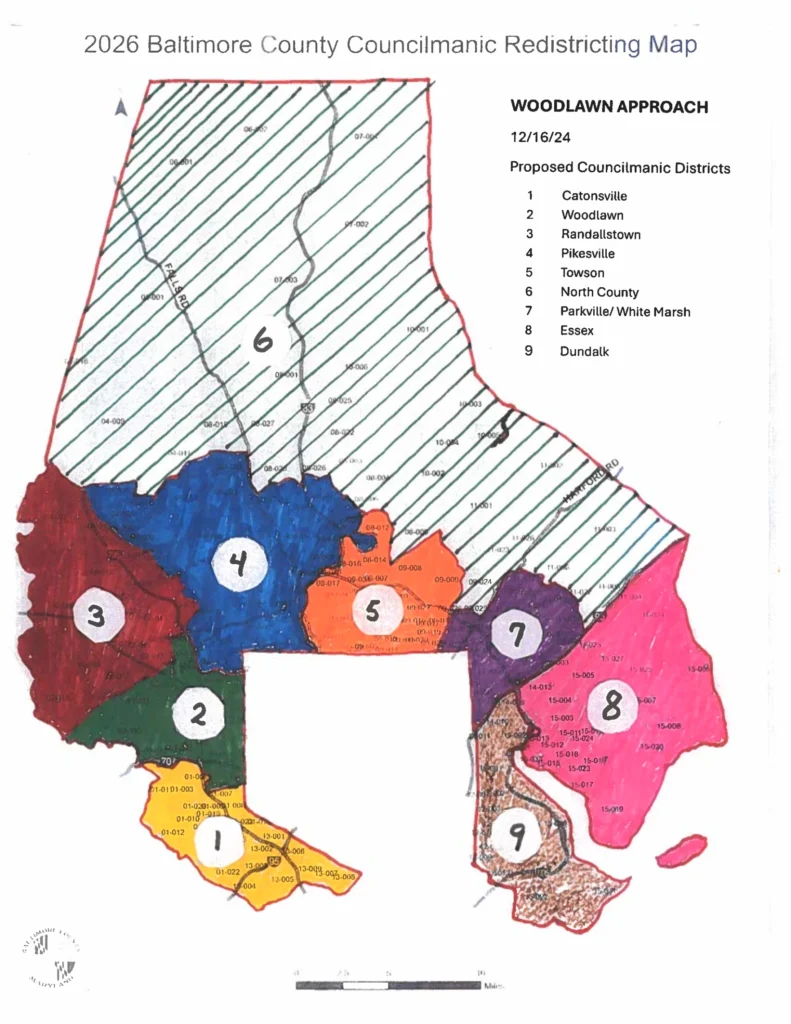
Photo caption: The “Woodlawn Approach” map creates two super Black majority districts. The second district would be more than 72% African American. The third would be more than 61%. (Photo courtesy of: Keith Dorsey)
Legal and Demographic Context
Redistricting in Baltimore County follows the decennial U.S. Census, which revealed notable population growth in suburban and urban areas of the county. The county’s population increase necessitated not only adjusting district boundaries but also expanding the number of districts to better represent diverse communities.
The commission was tasked with balancing multiple objectives: compliance with federal Voting Rights Act provisions, compactness and contiguity of districts, and preserving communities of interest. Additionally, they were mindful of public input, which ranged from calls to protect minority voting power to demands for competitive districts.
Why It Matters
- More granular representation, allowing council members to focus on smaller communities of ~95,000 residents instead of the previous ~122,000
- Enhanced minority representation, with the creation of four majority-minority districts intended to amplify historically underrepresented voices
- Precedent-setting redistricting effort, showcasing how voter-approved governance changes require rapid and inclusive boundary evaluations
Looking Ahead
- Council deliberation and debate: The Council will likely hold hearings and may propose amendments.
- Community engagement: Advocates on all sides are expected to mobilize around potential changes.
- Final adoption by October: A fast-tracked, focused process to ensure timely implementation before the 2026 elections.
Broader Context: Redistricting Across Maryland
Baltimore County’s redistricting is part of a larger statewide redistricting process following the 2020 Census. Other Maryland counties and legislative districts are undergoing similar scrutiny and revision to account for population changes and shifting political dynamics.
The redistricting process nationwide has been increasingly contentious as communities grapple with demographic shifts, legal requirements, and political strategies aimed at influencing electoral outcomes.
Conclusion
Baltimore County’s redistricting commission’s narrow approval of a new 9-district map marks a pivotal moment in the county’s political and demographic evolution. While the map aims to ensure more equitable and accurate representation, the razor-thin vote and vocal opposition underscore the challenges inherent in balancing legal mandates, community interests, and political realities.
As the county council prepares to review the map and community stakeholders prepare to voice their concerns, Baltimore County’s path forward will continue to unfold amid close public and legal scrutiny.


